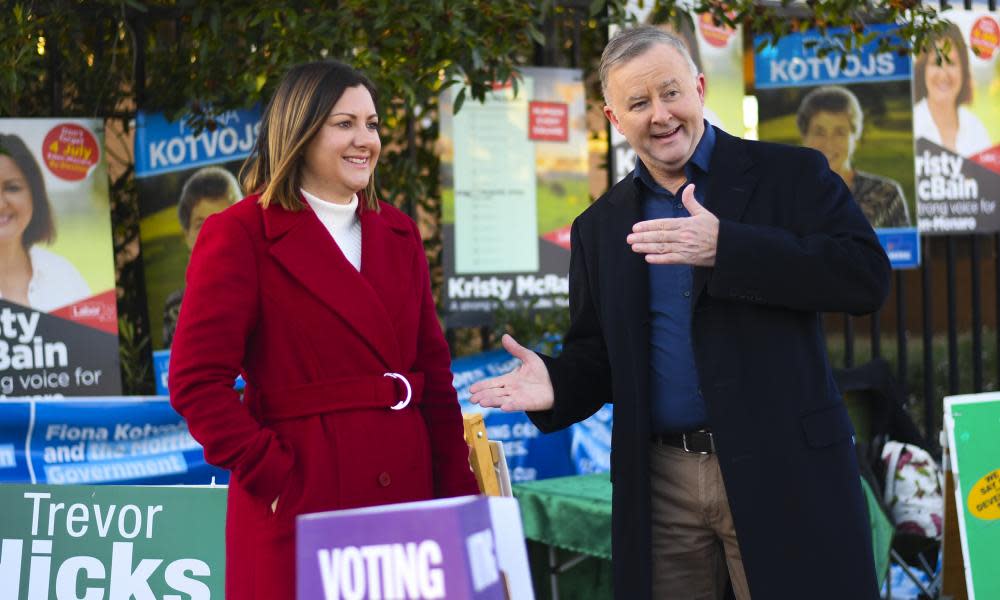Anthony Albanese will bank Labor's Eden-Monaro win, but may suspend the celebrations

We haven’t got an official result in Eden Monaro yet, but Labor has claimed victory, and we have enough information to be able to sketch out what happened in the contest.
Here’s a visual explanation that will be very familiar to Canberra residents and to holiday-makers. The swings varied by your preferred route to the south coast. If you generally take the Kings Highway route, you are driving through towns that swung to the Liberal party. If you drive down the Brown Mountain route through the Bega valley, then you are passing through swing-to-Labor territory.
Obviously there are variations within that trend but that’s the nub of it. It’s a north/south story. If you draw a line on a map from Batlow in the north-west of the electorate, through Adaminaby and on to Cobargo in the south-east, voters to the north of that line swung to the government, and people below that line swung to Labor.
Related: Labor's Kristy McBain claims victory in Eden-Monaro byelection
Before Saturday’s contest, there was a lot of focus on the loss of Mike Kelly’s personal vote – would the retirement of the popular incumbent spell disaster for Labor? Would the ALP be able to hold the seat with a lesser-known candidate? Cue much earnest hand-wringing and expectations management about the Mike Kelly effect.
But as it turned out, there wasn’t enough focus on the Kristy McBain effect in the contest. This byelection underscores a basic fact: in the rusted-off era, candidate selection matters. Building support from the ground up matters.
Labor’s vote in Queanbeyan on Saturday was very likely depressed because of Kelly’s departure, because Kelly was correctly regarded as a good bloke, and an effective representative. But I’m not sure how that gets separated from other factors – like the power of incumbency in the middle of a global health and economic crisis.
Also, did Scott Morrison’s defence pivot in the closing days of the contest influence the results? I flagged on Saturday that the byelection was one of the factors in the timing of the defence announcement.
But in any case, the weakness in Queanbeyan and surrounds was offset by what looks like a powerful personal vote for McBain in the south-east corner of the electorate, which is her stomping ground. Voters swung to the Liberals in Queanbeyan, but they swung harder to McBain in the south-east.
Superficially, this could be credited as a bushfire effect rather than a McBain effect, until you look more closely at the booth data. Take just one example: the residents of Cobargo – the centre of a tragedy in January – swung to the Liberals on Saturday night.
Perhaps this is a bushfire effect in the sense locals accepted the government’s core message during the campaign: the fire clean up will move much faster if you send Fiona Kotvojs to Canberra, rather than a member of the opposition. Perhaps it was a tactical vote for progress rather than a conventional protest vote? Perhaps it, too, is evidence of a candidate effect, given Kotvojs is a member of the Cobargo RFS? All this gets pretty interesting once you start delving in.
Now, of course, Sunday being the day after the (long) night before, we are drowning in spin. Depending on the talking points you’ve been handed, this is either wonderful for the Liberals because they almost grabbed this seat when byelections generally deliver swings against incumbents, or this is a triumph for Labor because the opposition held the seat at a time when Scott Morrison is enjoying approval ratings north of 60%.
So what are the facts? Broadly the result on Saturday night mirrors the election result in the seat in the 2019 federal poll. We’ll see where the final count lands, but as of now, not much has shifted contest to contest, apart from Labor waking up to some of their own structural weaknesses in the federal poll, namely the absence of an effective postal vote strategy. Labor did better in the byelection with postal votes and with preference harvesting than it did in 2019.
Joel Fitzgibbon, never one for talking points, characterised the (likely) victory on Sunday morning as an “ugly” win for Labor, meaning it was a hard scramble for the incumbents to hold the territory rather than a portentous micro triumph suggestive of the end of the Morrison government.
That’s broadly right. But I think a couple of other things are worth noting. I know it was broadly the backroom expectation that Labor would prevail in this byelection, but I’m surprised Labor held the seat in the current electoral climate. Instinct suggested there could easily be a once-in-a-century upset.
I’m surprised we didn’t see a more definitive affirmation of the Coalition given the ever-present threat of the pandemic, given Morrison’s high approval ratings, given national polls suggest public trust is gradually being restored in the competency of government.
This suggests to me that voters are in a wait and watch mood rather than in an adulatory mood.
But the flipside of this, of course, is a status quo result in Eden Monaro means Labor remains a considerable distance from storming the Bastille.
Anthony Albanese will bank the win if that’s where this lands – in fact he already has. He declared victory on Sunday because it is important in the psychology of the thing to bring the hammer down, because a loss would have catapulted Labor back into nervous, corrosive, lethal, habits.
Albanese will be pleased to win, no doubt, and winning right now is an achievement a political leader will rightly bank.
But given the last five weeks have been a hard scramble for Labor to basically stand where they started, I suspect he’ll suspend the victory lap.

 Yahoo News
Yahoo News 
